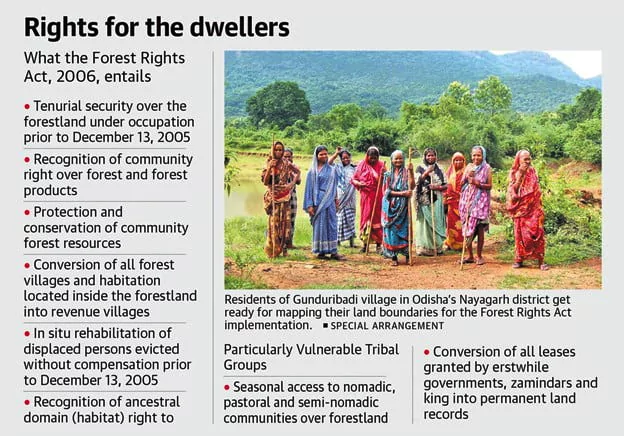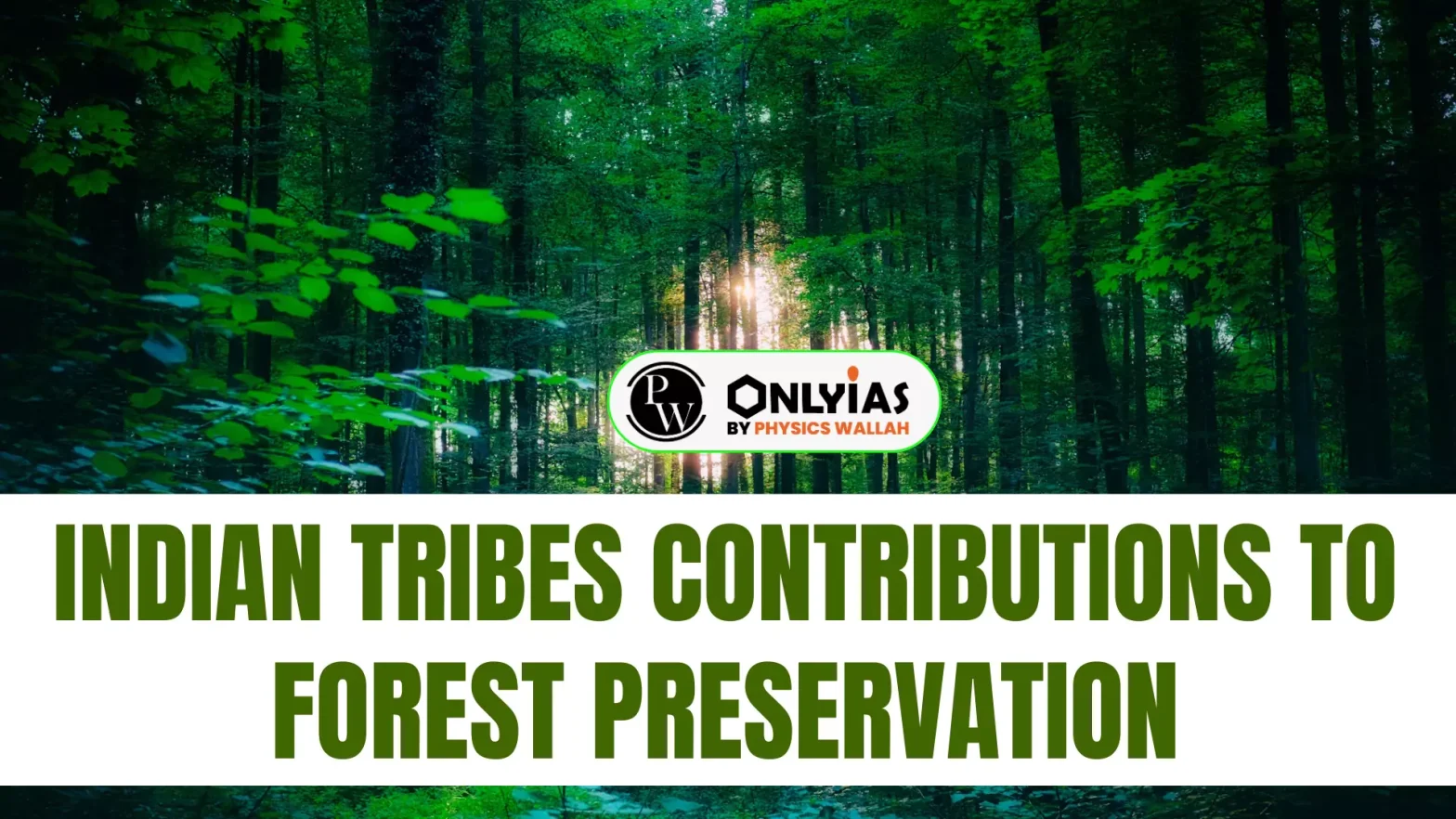Context
Recently, the Indian President highlighted the importance of listening to tribal communities to preserve forests as the collective wisdom accumulated by them over centuries can help to move forward on an ecologically sustainable path.
- Due to the serious challenge of climate change, the SC recently ruled that the right to be free from the adverse effects of climate change is a fundamental right under Articles 14 and 21 of the Constitution.
Enroll now for UPSC Online Course
Tribes in India
- Not Defined: The Indian Constitution does not define the term ‘tribe’.
- Article 342 of the Indian Constitution empowers the President to specify Scheduled Tribes.
- Fifth Schedule establishes Tribes’ Advisory Councils. It provides special provisions for administration and control of Scheduled areas and Scheduled Tribes.
- As per the Draft National Tribal Policy, 2006, India has 698 STs.
- Bhil is the largest tribal group followed by Gonds.
- Madhya Pradesh has the highest tribal population in India.
- Santhal is the oldest tribal group in India.
|
Indian Tribes Contributions to Forest Preservation
- Sustainable Agricultural & Fishing Practices:
- Apatani Tribe: In areas like the Ziro valley, Arunachal Pradesh, the Apatani tribes are known for their sustainable agriculture practices of wet rice cultivation.
- Land irrigation is facilitated by canals dug and linked to streams from hills. Soil fertility is maintained by organic wastes and the recycling of crop residues.
- Similarly, native animal populations like the Himalayan squirrel are protected through a mechanism called ‘Dapo’, where the community head lays down rules on hunting and extraction, non-adherence to which can lead to penalties.
- Kadars: The Kadars of Tamil Nadu pluck fruits and vegetables only from the mature stems of the plant, which are then cut and replanted for future harvest.
- Irulas, Muthuvas, and Malayalis: These tribes of South India, follow a mixed cropping system wherein several types of crops are grown simultaneously in a specific area.
- This prevents overexploitation of the water table and soil nutrients as different crops have different requirements and in addition, prevents soil erosion.
- Gond, Pradhan and Baiga: These communities of Madhya Pradesh undertake Utera farming.
-
- Utera Farming: It is a method where the next seeds are sown in paddy fields before the primary crops are harvested to make use of the existing moisture from the soil before the land dries up.
- They also follow the Badi cropping system in which fruit crops and trees are planted along the periphery serving as a barricade from droughts and heavy rains while preventing soil erosion.
- Mulching, burning of leaves for residue, and retainment of roots and stumps allow for soil fertility and nutrient cycling.
- Wancho and Nocte: These tribes of Arunachal Pradesh create obstructions in streams by using bamboo, stones, coir, and tree branches in which fishes get trapped and are then collected and distributed amongst the communities in a method known as Bheta.
- Adi and Galo: They employ Lipum fishing techniques wherein large bamboo baskets lined with seaweed are constructed and placed at the bottom of streams. The seaweed attracts small insects which in turn draw the attention of fishes.
- Fishes caught are inspected and juvenile fishes are released back into the stream and also this practice is carried out during the winter months to prevent people from fishing during the breeding season. In this manner, fish populations are kept intact while local needs are fulfilled.
- Preservation of Sacred Groves:
- Garasia: The Garasia tribes of Rajasthan are known to have extensive knowledge about the ethnomedicinal plants, many of which are listed in the IUCN Red List of threatened species. To protect them, tribal communities have developed patches of forest termed sacred groves for folk deities.
- Sustainable Utilization & Transhumance:
- Bhotias: This tribe of Central Himalayas follow the collection of medicinal plants by inspecting the maturity of the leaves to prevent overharvesting.
- Tribe members also cultivate barley and buckwheat in the upper valleys during summer for consumption. Once these crops are harvested, cattle and sheep are allowed to graze on the land.
- During this time, the upper valleys are prepared for cultivating crops which are then used once the produce is harvested for grazing activities.
- This seasonal cycle of farming and grazing allows for the utilisation of pastures and is called transhumance.
- Wildlife Protection:
- Adi Tribe: In terms of wildlife protection, tribal communities often employ totems and religious beliefs that restrict the culling of animals and certain plants. For the Adi tribes in Arunachal Pradesh, tigers, sparrows, and pangolins are believed to be well-wishers of humankind and hence are not hunted.
- It is also believed that cutting down banyan trees can lead to famine and death.
- Akas: Mount Vojo Phu is considered a sacred mountain for the Akas, a tribal community of Arunachal Pradesh and hence, access to the mountain is restricted in an effort to help preserve the local flora and fauna.
- For Promotion of Eco-tourism:
- Angami: Khonoma village in Nagaland (India’s first green village), which is managed by the Angami tribe, promotes community-based eco-tourism while preserving forests and traditional practices.
Enroll now for UPSC Online Classes
Policy Actions for Indian Tribes:

- High Dependency: As per the Census 2011, there are about 6,50,000 villages in the country, out of which nearly 1,70,000 villages are located in the proximity of forest areas, often referred as forest fringe villages.
- As per India State of Forest Report- 2019, published by Forest Survey of India, approximately 300 million people are dependent on forests.
- The National Forest Policy, 1988: Having regard to the symbiotic relationship between the tribal people and forests, the Policy focuses to associate the tribal communities closely in the protection, regeneration and development of forests as well as to provide gainful employment to people living in and around the forest.
- It also emphasizes that the life of tribals and other poor people living within and near forests revolves around forests and the rights and concessions enjoyed by them should be fully protected.
- Establishment of Joint Forest Management Committees (JFMCs) and Village Eco-Development Committees (EDCs): JFMCs and EDCs have been established, through participatory approaches, at the village levels involving local communities in forest protection, conservation, and management of forests, including enhancing the livelihoods of forest dependent communities.
- The Scheduled Tribes and Other Traditional Forest Dwellers (Recognition of Forest Rights) Act, 2006 (FRA, 2006): The Act encompasses rights of self-cultivation and habitation, community rights as well as recognition of traditional customary rights and right to protect, regenerate or conserve or manage any community forest resource for sustainable use.
- It recognizes the rights of the forest dwelling tribal communities and other traditional forest dwellers to forest resources, on which these communities were dependent for a variety of needs, including livelihood, habitation and other socio-cultural needs.
About Forest:
- According to the 1996 Godavarman Judgement: “forest” would include:
- Any land recorded as “forest” in government records; and
- Any land that satisfied the dictionary definition of forest. (The Oxford Dictionary defines forest as “a large area covered with trees and undergrowth.”)
Constitutional Framework For Forests In India:
- Inclusion in Concurrent List: Forests are classified under the Concurrent List of the Constitution of India.
- Transfer of Jurisdiction: The 42nd Amendment Act of 1976 transferred the jurisdiction over forests and protection of flora and fauna from the State List to the Concurrent List.
- Fundamental Duty: Article 51A (G) emphasises the essential obligation of citizens to shield and preserve the natural environment, consisting of forests.
- Directive Principles of State Policy: Article 48 A of the DPSP mandates Government’s efforts to preserve and improve the environment, consisting of safeguarding forests and the natural world.
|
The Importance of Protecting Indian Tribes
- Stakeholders of Indigenous Knowledge: It is imperative to focus ecological protection on enhancing tribal communities as they are key stakeholders of indigenous knowledge.
- Thus, impetus should be provided to tribal communities to share their knowledge towards conservation and indigenous methods that enable researchers, policymakers, and conservationists.
- Policy Formulation: Some of their practices have helped formulate policies on conservation.
- Example: Indian tribes in the Dindori district of Madhya Pradesh grow red gram along with rice to prevent soil erosion, these are exchanged with Mahua flowers and black gram to replenish soil fertility.
- This sustainable model was borrowed by the Regional Agriculture Station and further refined to propagate sustainable agricultural practices.
- Similarly, the Indian Council of Agricultural Research (ICAR) implemented the National Agricultural Technology Project to test out the Utera cropping system in 1999.
- Significant Contributions: Tribal communities constitute around 9% of the Indian population with the majority residing in Central India. These communities have accumulated indigenous knowledge on agriculture and cohabiting that have little consequence on the forest ecosystems.
- For centuries, Indian tribes have helped preserve natural habitats and promote conservation through sustainable practices in farming, fishing, and cohabiting spaces with wildlife. Their rituals and beliefs further contribute to environmental protection.
- Cost Effective Strategies Providers: Regarding traditional knowledge, the Food and Agriculture Organisation (FAO) has revealed that indigenous and local communities utilise systems of production that are less damaging to the ecosystem of forests.
- Recognized by International Community: During the COP26 UN climate summit, a historic pledge (worth $19.2 billion) was made by 100 countries to end deforestation by 2030, and a substantial part of this fund is to be allocated towards supporting indigenous communities.
- The first ever Global Assessment Report on Biodiversity and Ecosystem Services, which assessed the status of biodiversity on the planet, also said that the rate of decline in biodiversity is lower in areas where indigenous people own land.
- However, the knowledge and perspective of the indigenous communities is absent in the global approaches to conservation.
Challenges Faced by Indian Tribes

- Displacement and Rehabilitation: The acquisition of tribal land for large-scale industrial projects, such as steel plants, power installations, and dams, has resulted in massive displacement of tribal populations. This disruption forces tribals to migrate to urban areas, where they struggle to adapt to a different way of life.
- The creation of protected land by the government has led to several displacements and the 2006 Forest Rights Act has been an inadequate response to address land rights, leading to the forced eviction of several tribal dwellers.
- Threats to Traditional Livelihood Practices: Traditional livelihood practices such as shifting cultivation, hunting and gathering are under threat due to conservation policies and restrictions imposed by forest departments.
- The Van Gujjars, a semi-nomadic pastoral community in the Himalayas, have faced attempts by forest departments to restrict their entry into forests, which is essential for their transhumance practices.
- Loss of Traditional Knowledge: With the migration of tribals to urban areas in search of better opportunities, there is a risk of losing the traditional knowledge and practices, which poses a significant challenge to the conservation of forests and biodiversity.
- Tribal life is largely an embodiment of conscious extraction without depletion and a sense of responsibility towards future generations. The Soliga tribes of Karnataka take honey from combs and leave some on forest floors for tiger and bear cubs to consume.
- They also light controlled fires to prevent invasive plants that can destroy the forests and thereby affect animal life and the forest food chain.
- Climate Change: Tribal communities are among the most vulnerable to the impacts of climate change. The Khasi tribe in Meghalaya has witnessed a decline in their traditional agricultural practices due to changing rainfall patterns and temperature increases.
- Others: Cases of harassment, bribes, delays in claim settlement, and illegal evictions have also been reported. In addition to this, the objective of conservation is also not met.
Way Forward
- Balancing Tradition and Modernity: The dual wheels of development—tradition and modernity—must be balanced to address current environmental challenges. The exploitation of nature in pursuit of modernity has often led to environmental degradation.
- Embracing traditional wisdom alongside modern practices can foster an ecologically sustainable, ethically desirable, and socially just future.
- Tribal Wisdom for Sustainability: Tribal communities, with their deep-rooted knowledge of nature’s laws, offer invaluable insights into sustainable living.
- Learning Sustainable Practices: Forest officers are encouraged to engage closely with tribal communities, learning from their sustainable practices and helping to elevate their living standards.
- Inclusive Development with Tribal Communities: Ensuring tribal communities’ participation in development processes is crucial for inclusive and sustainable progress.
- Promote Eco-tourism Initiatives: It could provide them with alternative livelihood opportunities while preserving their cultural heritage and traditional knowledge.
- Implement Tribal Forest Guardians Program: Under this program, members of tribal communities are trained and employed as forest guards or eco-guides. It can leverage their intimate knowledge of the local ecosystems, promote ownership and provide sustainable livelihoods.
- Tribal Knowledge Banks: There is a need to document and integrate traditional ecological knowledge of tribal communities into modern conservation strategies to achieve a positive gain.
- Forest Product Value Addition and Marketing: There is a need to establish value-addition and marketing initiatives for forest products collected by tribal communities, which can provide sustainable livelihoods while incentivizing the conservation of forest resources by the tribes.
- Strengthening of Participatory Forest Management & Joint Forest Management (JFM) program: It could ensure greater representation and decision-making powers for tribal communities, recognizing their traditional knowledge and practices.
Enroll now for UPSC Online Course
![]() 27 May 2024
27 May 2024


